Board Layout
The look and layout is very similar to the X38T-DQ6 – all of the pin-outs, SATA ports and PCI-Express sockets are the same but there are still a few subtle changes that have been made. The north bridge cooling is now a bit bigger, but there are still two heatpipes going from this to the heatsink cooling the PWM stack.There are two PCI-Express x16 2.0 slots present, meaning there are also get a couple of PCI slots and three PCI-Express x1 expansion slots available. The other benefit of not cramming more than a couple of PCIe x16 slots in is that it leaves plenty of breathing room between them for graphics cards to be effectively cooled.
While there have been conflicts with Gigabyte P35 boards where SATA ports were inaccessible because they weren’t at 90 degrees to the edge of the board, the same thankfully isn’t true here.
All the connectors, pin-outs and sockets are easy to get to, even if you drop in two Radeon HD 3870 X2 graphics cards. Our only complaint is that the memory sockets are a bit low, the front panel audio pin-out is on the wrong side of the board and the 12V 8-pin EPS connector is difficult to get to – apart from that, Gigabyte has hit the nail pretty much right on the head.
As usual Gigabyte includes its Ultra Durable 2 branding – this is where not only the entire board gets decked in solid aluminium capped capacitors for a longer life, but as it’s a DQ6 the capacitors are also of the low ESR surface mount ilk. While Gigabyte has been quick to say how great they are, we’ve talked to several other companies about them too. As we expected, those that don’t use them tend to pooh-pooh the need to use them and also their actual benefit, but we at least have to give Gigabyte credit for staying ahead of the game and trying to do something others don't. We've seen the Low ESR SMD caps on some sound cards where it's even more sensitive to noise, so we know Gigabyte is at least gunning in the right direction.


The power phases for memory and north bridge have been updated from one to two sealed ferrite chokes, although the number of MOSFETs remains unchanged.
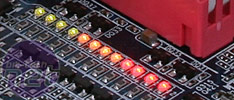 The extra Molex power connector has disappeared too – it’s been replaced by the new “Phase LED[s].” There are twelve of them in total and they go from green to yellow to red as more power phases are being used.
The extra Molex power connector has disappeared too – it’s been replaced by the new “Phase LED[s].” There are twelve of them in total and they go from green to yellow to red as more power phases are being used.Gigabyte still includes its Crazy-Cool on the back of the board to direct heat away from the CPU socket – it’s a great idea but as it’s also tied into retaining the north bridge heatsink down. This has prevented a CPU cooler with a rear retention mount from being used in the past, but Gigabyte has listened to our concerns and this has now been changed. In the box is a couple of screws for the north bridge heatsink, so you can remove the Crazy-Cool and still screw down the north bridge and use the heatpipes. This is undoubtedly a great idea and, because they are sprung, you get a solid contact pressure as well. However, the idea isn’t without its problems – because the screws are so small, we found that they’re a complete and utter pain in the backside to screw in without slipping and cutting into the PCB with your screwdriver.
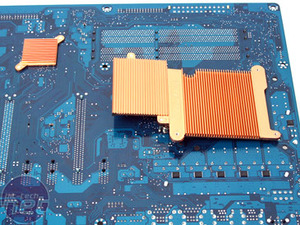
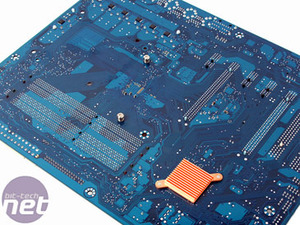
Taking off the Crazy-Cool and replacing it with the simpler screws now allows heatsinks with rear mounting plates. Click to enlarge
The big thing Gigabyte is missing—and for a DQ6 this is a feature that costs virtually nothing and it should absolutely be included—is the onboard power, reset and clear CMOS buttons. The clear CMOS should be there at a bare minimum – at the moment you have to manually short a pair of pins right by the battery.
This doesn’t mar what is a great layout on the whole with some solid features. However, we feel that Gigabyte really needs to evolve its DQ6 board design by mirroring the packaging with its colour scheme – this is especially needed when you consider that the DS4/DS5 boards offer very similar features and the DS5 is often at a far more attractive price point. On looks alone, the X48T-DQ6 could be any other Gigabyte board, so the incentive for what used to be a cutting edge DQ6 has dropped quite substantially when you compare it to the Asus Republic of Gamer or Foxconn Quantum Force series boards that command a similar premium.

MSI MPG Velox 100R Chassis Review
October 14 2021 | 15:04


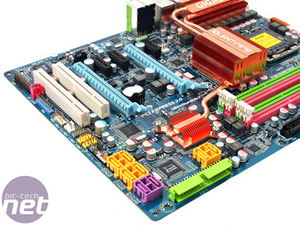
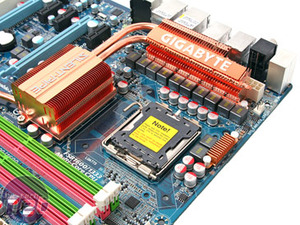







Want to comment? Please log in.